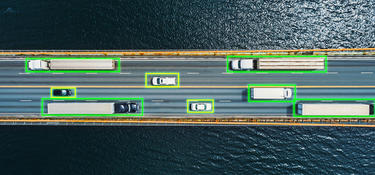

According to a recent study by BloombergNEF, medium and heavy-duty commercial vehicles own a 30% share of current road transport carbon dioxide emissions.1 This data, along with regulations in the form of both mandates and incentives, have been pivotal in prompting the logistics industry to transition to EVs for freight and delivery. The same BloombergNEF report highlights cost-savings potential for heavy-duty EV truck, finding them to now be “as cheap as diesel equivalents.”2 In addition to sustainability goals and cost saving, the improved efficiency offered by EV tech advancements are intensifying an exciting transition today’s fleet operators can’t afford to ignore.
The development and deployment of high-capacity battery packs, electric powertrains with higher torque and hauling power, and high-throughput charging stations are examples of innovations making fleets more attractive. Case in point: A 2023 IEA report on global heavy-duty EV trends shows “more than half [of new zero-emissions vehicle models in 2022] were either medium-duty trucks (over 60 models) or heavy-duty trucks (over 50 models).”3 The dual imperatives of reducing greenhouse gas emissions and achieving cost efficiencies mean the fleet of the future is getting an overhaul.
Orchestrating efficient, scalable operational practices is never a simple task for fleet operators, and adapting to an electrified fleet requires new considerations and upfront investments. The good news is that we have the technology to adapt, and moving toward electrification is not solely about sustainability: EVs represent a better way to do business, where operational efficiency and sustainable practices work in harmony.
Overcome Common Challenges
Constructing an efficient charging infrastructure is complex and not without challenges. Fleet managers must consider multiple factors, such as:
- Fleet size and composition
- Route dynamics and vehicle use
- Charging station location and density
- Integration with renewable energy sources
- Technology-driven scheduling
- Real-time energy management
- Infrastructure flexibility and future-proofing
- Partnerships with energy providers and infrastructure experts
The fleet of tomorrow will require efficient charging infrastructures that meet the demands of both present-day logistics and future technology. Consequently, a sophisticated software framework—engineered to navigate the complexities of energy usage, vehicle availability and cost considerations—is vital.

Fleet Management Software: Essential for the Global Energy Transition
A successful transition to EV fleets is as dependent on fleet management software (FMS) as it is on the actual vehicles. FMS systems offer real-time insights into vehicle performance, charger status, energy consumption and battery health—enabling operators to maximize efficiency and minimize downtime. An FMS with predictive analytics is instrumental to plan optimal routes and charging schedules. For example, well-designed FMS systems with real-time information can achieve greater than 99% uptime on EV chargers, ensuring no downtime for operations.2
Effective FMS systems optimize electric vehicles, enabling efficiency and ensuring the full potential of EV fleets. A variety of FMS systems are available, but the good ones are built on three pillars: real-time monitoring, EV telematics and energy management.
- Real-time monitoring
Real-time monitoring gives fleet operators precise, instantaneous data of vehicle locations and statuses. It enables swift decision-making, even in dynamic and unpredictable conditions, and ensures continuous fleet efficiency. Real-time monitoring can unearth patterns and pinpoint opportunities for efficiency enhancements, leading to significant operational improvements. - EV telematics
The integration of telematics into EVs is revolutionary. Telematics offer a deep look into vehicle diagnostics—from battery usage and temperature to motor and electrical system functions. This real-time data is crucial for predictive maintenance, potentially averting costly repairs and downtime. Equally significant, EV telematics inform smart-charging strategies, thereby optimizing battery performance and longevity. These advanced analytics drive economic and environmental gains simultaneously. - Energy management
Effective energy management is arguably the most critical aspect of electrification. In addition to maximizing conservation, it provides the opportunity to toggle between power sources (e.g., renewable, backup or grid), as well as identify optimal charging times and durations to capitalize on fluctuating energy prices, avoid peak-demand intervals, prolong battery life and reduce costs. Incorporating energy management into EV fleet operations represents both sustainable energy practices and operational efficiency.

FMS Drives Operational Savings
Using advanced FMS ensures heavy-duty EV fleets achieve maximum operational readiness and longevity, which provides a compelling list of benefits for fleet managers:
- Optimized charging: A cutting-edge FMS will integrate local utility tariffs by leveraging real-time data on electricity costs to calculate the most cost-effective periods for charging, ensuring a schedule that’s both energy conscious and economical. Additionally, algorithm-based monitoring and oversight of precise charging schedules mitigate the risk of overcharging and premature battery degradation.
- Data analysis: Robust analytics dashboards dissect vast volumes of operational data and transform them into actionable insights, so fleet managers can pinpoint efficiency bottlenecks, predict maintenance needs and determine optimal routing. Real-time updates and in-depth metrics—such as detailed energy usage, EV idle times and critical fault alerts (among others)—allow fleet operators to identify areas for optimization and implement timely and strategic interventions.
- Remote access: Remote access allows fleet operators to manage vehicles across a vast network, regardless of the operator’s physical location.
- Cost savings: FMS data contributes to a lower total cost of ownership (TCO) for heavy-duty EVs. Intelligent data analysis leads to optimized routing (by reducing unnecessary mileage) and extends the operational life for each EV (by avoiding overexertion and scheduling proactive maintenance that prevents escalation to costly repairs). For example, FMS systems can facilitate effective predictive maintenance programs for fleets, which the U.S. Department of Energy estimates will reduce maintenance costs by 25% to 30%, eliminate breakdowns by 70% to 75% and reduce downtime by 35% to 45%.
How to Choose the Right Fleet Management Software
Selecting the right FMS is on par with selecting the appropriate EVs. When researching FMS options, consider the following:
- Integrative capacity allows an FMS to sync with third-party systems, such as Geotab or manufacturer-specific platforms, like those offered by Rivian and Volvo. It’s critical for modern fleet systems because integrative capacity facilitates the mutual exchange of data, and data is the lifeblood of any FMS.
- Real-time data availability is indispensable. It represents the evolution of fleet management from reactive to proactive, where every analytic point is leveraged to bolster economic efficacy and environmental accountability.
- Advanced telematics features, such as geo maps of EVs and fault alerts, are fundamental for real-time visibility and control across fleet operations. These capabilities allow fleet operators to track vehicle locations and diagnose maintenance needs accurately.
- Energy management tools enable optimized energy consumption across the fleet. Features like automated charging routines ensure EVs are charged during off-peak hours to capitalize on lower electricity rates and promote grid sustainability. Forecasting accurately, establishing charging schedules and modulating charging speeds help balance the competing demands of operational uptime, energy conservation and fiscal responsibility.
- Scalability is essential for any enterprise, so ensuring an FMS will stretch to meet escalating demands is critical. Efficient scalability permits a business to mature its fleet without prohibitive increases in operational complexity or cost.
- Customer support is more than an extension of service; it’s foundational to a robust FMS system. Investigate typical response times and an FMS system’s track record of resolving issues promptly.

Join the Electric Future
Choosing the right FMS system for your business isn't simply about the number of features or lowest price. Don’t commit until you find a solution that will best fulfill your specific requirements and enhance your fleet operations.
All leading FMS options have a library of educational content to study, and this is a good place to start. However speak directly with a representative before making a final decision. This will give you the chance to confirm and clarify details from product and marketing materials, as well as pose granular questions about your fleet’s highly specific needs.


